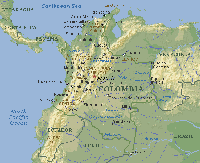
Introduction
(photo:http://www.eat.org.mx/paises/colmapa2.htm)
We would like to introduce our country to you. The country we would like you discover and to learn to love. Colombia, the birthplace of your child. The most controversial in the media, the most mysterious and misunderstoodin South America. If you choose to come to this country for adoption, it means that at least in part, you have surpassed the barrier of prejudice of many people who find Colombia a country impossible to visit. For many people Colombia means violence, drugs, drug trafficking, guerrillas and paramilitaries. But Colombia is also the joy of living, human development, industry, gold, emeralds, fruits, coffee, bananas ... Colombia is indigenous, black, white, mulatto, and at the same time coexistence between races. Its geographic location and area of over one million square kilometers make Colombia a particularly privileged country, the fifth largest in America. Colombia has coasts on both the Atlantic and Pacific oceans, and has mountains that run from north to south by three ranges of the Andean mountains. The Amazon River also contributes to its natural wealth. Colombia holds 10% of the earth's total species of flora and fauna. In fact, it is the second-most biodiverse country in the world, with more species of birds than any other country. Nine million hectares are currently allocated as nature reserves (the most in the world, relative to the size of the country).
History
(photo:DVD: Colombia Qué lindo país.Fonomusica.
Distribuidor exclusivo)

Before the arrival of the Spanish, many indigenous peoples lived in our territories. Various ethnic groups and tribes with different levels of development inhabited the rich valleys between the Andean mountains. The most advanced cultures were the Chibcha and the Muiscas, who lived in what are today the departments of Boyacá and Cundinamarca. Those communities had a productive organization and a commercial development based on cultural and scientific knowledge. The Chibcha of the western region developed aesthetics and art as a religion and perfected techniques of metal production, particularly gold. To the south was the Paez community, totally devoted to agriculture. This community developed advanced and productive systems on the slopes of ridges.
Christopher Columbus and his sailors made exploration voyages between 1499 and 1503 but it was Vasco Núñez de Balboa who, in 1513, embarked from the Magdalena River in search "El Dorado". The first cities were then founded: Santa Marta (1525), Cartagena (1533), Popayan and Cali (1536) and Bogotá (1538). In the highlands of Cundinamarca, where the reigning sovereign Bacatá (from which the name of Bogotá is derived) arose the legend of El Dorado. This colombian legend tell a story in which each new chieftain rose to a raft and in the middle of the Guatavita lagoon, covered with gold dust. This image created in the Spanish an obsessive ambition for wealth.
Indigenous people were forced to cultivate plots of land, partitioned by their "conquerors." The conquest extended from 1626 until 1649 and relied on forced labor initially from indigenous Colombians, and later African slaves. The settlement was later based on the immigration of Europeans and on African slave trade. The submission to the Spanish crown for 3 centuries, the independence from the British provinces, and later the French revolution fueled the desire for independence in Latin America. Simón Bolívar (1783-1830), a Venezuelan general born in Caracas, was one of the leading patriots who shaped the current independence of Colombia (and four other Latin American countries). Political instability in these decolonized countries in the nineteenth century remained a constant in the life of the country.
RESOURCES
(photo:DVD: Colombia Qué lindo país.Fonomusica. Distribuidor
exclusivo)

At present, Colombia is the third most populous country in America with nearly 45 million people, almost half under the age of 20. Literacy is 80%, and higher education is guaranteed by more than 300 universities, both public and private. Despite freedom of religion Colombia is predominantly catholic, due to its Spanish heritage. Colombia is one the most important producer of coffee and emeralds, the second largest exporter of flowers and bananas and the fourth largest exporter of coal with more than 23 million tons /year. In Latin America Colombia is the second largest exporter of gold, the third largest exporter of oil and the fourth largest producer of sugarcane and livestock. Other important products are fruits, cotton and tobacco. The main industries are textiles, clothing, food, beverages, machinery, chemicals, petroleum products and handicrafts.


